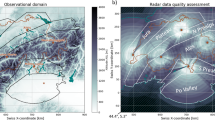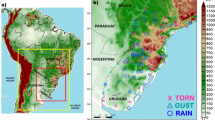Abstract
Severe weather reports and composite radar reflectivity data from 2010–14 over North China were used to analyze the distribution of severe convective wind (SCW) events and their organizational modes of radar reflectivity. The six organizational modes for SCW events (and their proportions) were cluster cells (35.4%), squall lines (18.4%), nonlinear-shaped systems (17.8%), broken lines (11.6%), individual cells (1.2%), and bow echoes (0.5%). The peak month for both squall lines and broken lines was June, whereas it was July for the other four modes. The highest numbers of SCW events were over the mountains, which were generally associated with disorganized systems of cluster cells. In contrast, SCW associated with linear systems occurred mainly over the plains, where stations recorded an average of less than one SCW event per year. Regions with a high frequency of SCW associated with nonlinear-shaped systems also experienced many SCW events associated with squall lines. Values of convective available potential energy, precipitable water, 0–3-km shear, and 0–6-km shear, were demonstrably larger over the plains than over the mountains, which had an evident effect on the organizational modes of SCW events. Therefore, topography may be an important factor in the organizational modes for SCW events over North China.
摘要
利用雷达组合反射率资料, 对2010-14年华北雷暴大风的对流组织进行分类研究.结果表明: 华北雷暴大风的六类对流组织类型所占比例分别为: 多单体(-35.4%),飑线(-18.4%),非线性对流(-17.8%),破碎线性对流(-11.6%),单体(-1.2%),弓形回波(-0.5%).飑线和破碎线性对流两类雷暴大风在6月份最多, 而其他四类对流组织峰值为7月份.华北山区发生雷暴大风多于平原地区.非线性对流和飑线两类雷暴大风高发区相似.海拔较高的山区雷暴大风的对流组织性较弱且多为多单体组织类型, 而平原地区的雷暴大风多由组织性较强的线性对流产生.这可能和山区和平原地区的大尺度环境配置有关, 因为平原地区雷暴大风的大气可降水量、对流有效位能及风垂直切变更强.因此, 地形是影响华北雷暴大风组织类型的一个重要原因.
Similar content being viewed by others
References
Bluestein, H. B., and M. H. Jain, 1985: Formation of mesoscale lines of precipitation: Severe squall lines in Oklahoma during the spring. J. Atmos. Sci., 42(16), 1711–1732, https://doi.org/10.1175/1520-0469(1985)042<1711:FOMLOP>2.0.CO;2.
Brooks, H. E., 2006: A global view of severe thunderstorms: Estimating the current distribution and possible future changes. Preprints, Symposium on the Challenges of Severe Convective Storms, Atlanta, GA, American Meteorological Society, Conference CD.
Brooks, H. E., J.W. Lee, and J. P. Craven, 2003: The spatial distribution of severe thunderstorm and tornado environments from global reanalysis data. Atmospheric Research, 67–68, 73–94, https://doi.org/10.1016/S0169-8095(03)00045-0.
Brooks, H. E., A. R. Anderson, K. Riemann, I. Ebbers, and H. Flachs, 2007: Climatological aspects of convective parameters from the NCAR/NCEP reanalysis. Atmospheric Research, 83(2–4), 294–305, https://doi.org/10.1016/j.atmosres.2005.08.005.
Doswell III, C. A., 1987: The distinction between large-scale and mesoscale contribution to severe convection: A case study example. Wea. Forecasting, 2(1), 3–16, https://doi.org/10.1175/1520-0434(1987)002<0003:TDBLSA>2.0.CO;2.
Duda, J. D., and W. A. Gallus Jr., 2010: Spring and summer midwestern severe weather reports in supercells compared to other morphologies. Wea. Forecasting, 25(1), 190–206, https://doi.org/10.1175/2009WAF2222338.1.
Fujita, T. T., 1978: Manual of downburst identification for Project Nimrod. Satellite and Mesometeorology Research Paper No. 156, Department of Geophysical Sciences, University of Chicago, 104 pp.
Gallus Jr, W. A., N. A., Snook, and E. V., Johnson, 2008: Spring and summer severe weather reports over the Midwest as a function of convective mode: A preliminary study. Wea. Forecasting, 23(1), 101–113, https://doi.org/10.1175/2007WAF2006120.1.
Jirak, I. L., W. R. Cotton, and R. L. McAnelly, 2003: Satellite and radar survey of mesoscale convective system development. Mon. Wea. Rev., 131(10), 2428–2449, https://doi.org/10.1175/1520-0493(2003)131<2428:SARSOM>2.0.CO;2.
Johnson, R. H., and J. F. Bresch, 1991: Diagnosed characteristics of precipitation systems over Taiwan during the May June 1987 TAMEX. Mon. Wea. Rev., 119(11), 2540–2557, https://doi.org/10.1175/1520-0493(1991)119<2540:DCOPSO>2.0.CO;2.
Klimowski, B. A., M. J., Bunkers, M. R., Hjelmfelt, and J. N., Covert, 2003: Severe convective windstorms over the northern high plains of the United States. Wea. Forecasting, 18(3), 502–519, https://doi.org/10.1175/1520-0434(2003)18<502: SCWOTN>2.0.CO;2.
Klimowski, B. A., M. R., Hjelmfelt, and M. J. Bunkers, 2004: Radar observations of the early evolution of bow echoes. Wea. Forecasting, 19(4), 727–734, https://doi.org/10.1175/1520-0434(2004)019<0727:ROOTEE>2.0.CO;2.
Lee, J. W., 2002: Tornado proximity soundings from the NCEP/NCAR reanalysis data. M.S. thesis, University of Oklahoma, 61 pp.
Maddox, R. A., 1980: Mesoscale convective complexes. Bull. Amer. Meteor. Soc., 61(11), 1374–1387.
Moller, A. R., C. A. Doswell III, M. P. Foster, and G. R. Woodall, 1994: The operational recognition of supercell thunderstorm environments and storm structures. Wea. Forecasting, 9(3), 327–347, https://doi.org/10.1175/1520-0434(1994)009 <0327:TOROST>2.0.CO;2.
Parker, M. D., and R. H., Johnson, 2000: Organizational modes of midlatitude mesoscale convective systems. Mon. Wea. Rev., 128(10), 3413–3436, https://doi.org/10.1175/1520-0493(2001)129<3413:OMOMMC>2.0.CO;2.
Przybylinski, R. W., 1995: The bow echo: Observations, numerical simulations, and severe weather detection methods. Wea. Forecasting, 10(2), 203–218, https://doi.org/10.1175/1520-0434(1995)010<0203:TBEONS>2.0.CO;2.
Schoen, J. M., and W. S., Ashley, 2011: A climatology of fatal convective wind events by storm type. Wea. Forecasting, 26(1), 109–121, https://doi.org/10.1175/2010WAF2222428.1.
Smith, B. T., R. L. Thompson, J. S. Grams, C. Broyles, and H. E. Brooks, 2012: Convective modes for significant severe thunderstorms in the contiguous United States. Part I: Storm classification and climatology. Wea. Forecasting, 27(5), 1114–1135, https://doi.org/10.1175/WAF-D-11-00115.1.
Smith, B. T., T. E. Castellanos, A. C. Winters, C. M. Mead, A. R. Dean, and R. L. Thompson, 2013: Measured severe convective wind climatology and associated convective modes of thunderstorms in the contiguous United States, 2003–09. Wea. Forecasting, 28(1), 229–236, https://doi.org/10.1175/WAF-D-12-00096.1.
Smull, B. F., and R. A. Houze Jr, 1985: A midlatitude squall line with a trailing region of stratiform rain: Radar and satellite observations. Mon. Wea. Rev., 113(1), 117–133, https://doi.org/10.1175/1520-0493(1985)113<0117:AMSLWA>2.0.CO;2.
Sun, J. H., L. L. Zheng, and S. X. Zhao, 2014: Impact of moisture on the organizational mode and intensity of squall lines determined through numerical experiments. Chinese Journal of Atmospheric Sciences, 38(4), 742–755, https://doi.org/10.3878/j.issn.1006-9895.2013.13187. (in Chinese)
Wang, X. M., X. G. Zhou, and X. D. Yu, 2013: Comparative study of environmental characteristics of a windstorm and their impacts on storm structures. Acta Meteorologica Sinica, 71(5), 839–852, https://doi.org/10.11676/qxxb2013.073. (in Chinese)
Weisman, M. L., 2001: Bow echoes: A tribute to T. T. Fujita. Bull. Amer. Meteor. Soc., 82, 97–116, https://doi.org/10.1175/1520-0477(2001)082<0097:BEATTT>2.3.CO;2.
Yang, X.-L., and J.-H. Sun, 2014: The characteristics of cloudto-ground lightning activity with severe thunderstorm wind in South and North China. Atmospheric and Oceanic Science Letters, 7, 571–576, https://doi.org/10.3878/AOSL20140046.
Yang, X. L., J. H. Sun, and Y. G. Zheng, 2017: A 5-yr climatology of severe convective wind events over China. Wea. Forecasting, 32(4), 1289–1299, https://doi.org/10.1175/WAF-D-16-0101.1.
Yu, X. D., X. P. Yao, T. N. Xiong, X. G. Zhou, H. Wu, B. S. Deng, and Q. Song, 2006: Principle and Operation Application of Doppler Weather Radar. China Meteorological Press, Beijing, 314 pp. (in Chinese)
Zheng, L. L., J. H. Sun, X. L. Zhang, and C. H. Liu., 2013: Organizational modes of mesoscale convective systems over central East China. Wea. Forecasting, 28(5), 1081–1098, https://doi.org/10.1175/WAF-D-12-00088.1.
Acknowledgements
The Beijing Meteorological Service and the National Meteorological Center provided the weather reports, composite radar reflectivity data, and severe weather report data used in this study. This research was supported by the National Natural Science Foundation of China (Grant No. 41375051 and 41505038).
Author information
Authors and Affiliations
Corresponding author
Rights and permissions
About this article
Cite this article
Yang, X., Sun, J. Organizational Modes of Severe Wind-producing Convective Systems over North China. Adv. Atmos. Sci. 35, 540–549 (2018). https://doi.org/10.1007/s00376-017-7114-2
Received:
Revised:
Accepted:
Published:
Issue Date:
DOI: https://doi.org/10.1007/s00376-017-7114-2




